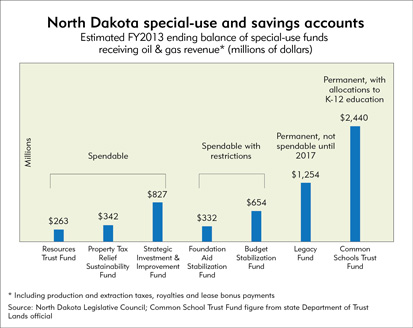Over the past several state budgets, North Dakota lawmakers have created a quirky, idiosyncratic system for allocating the gusher of oil and gas tax revenue coming into state coffers. As this revenue has grown, so have the number of recipients, the amount of money received and the overall complexity of the allocation system.
Among numerous sources, nary a person said they fully understood the state’s allocation system for oil and gas taxes.
“It’s very complicated. I don’t think the average North Dakotan could tell you what they have in all those funds. I couldn’t tell you, and I follow this stuff,” said Barry Wilfahrt, president and CEO of the Grand Forks/East Grand Forks Chamber of Commerce.
Senate Minority Leader Mac Schneider (D-Grand Forks) acknowledged, “You almost need an astrophysics degree from MIT” to understand the many different recipients of money and how amounts are determined.
Those living in oil country are of the same opinion. Shawn Kessel, Dickinson city administrator, said the distribution mechanism “fills buckets after buckets after buckets. It’s hard for me to keep track.”
“There are pots for this and pots for that,” said Deb Nelson, head of Vision West ND, a Dickinson-based consortium of oil-impacted local governments and other organizations. “To the layperson, it’s a monstrosity.”
In previous years, that might not have mattered so much. A decade ago, severance taxes on oil and gas production contributed about $120 million to the state budget. But in the just-completed 2011-13 biennium, they tallied $3.8 billion, which doesn’t include $560 million earned (as of March) in royalty fees and lease-bonus payments for oil activity on state-owned land.
The state spreads that largesse among a dozen general recipients (see graphic). That’s the simple part. The complex part has to do with the statutes and formulas that generate the amounts that go in each pot. For example, the state charges a separate 5 percent production tax and 6.5 percent extraction tax, and revenue from each tax fund’s different buckets, but there’s also some crossover.
The pots also have different fiscal goals. Some are intended to fund the regular business of government. Of the $3.8 billion in 2011-13, $300 million went to the state’s general fund and $410 million was sent directly to counties, cities and tribes to help them deal with infrastructure and other impacts of oil and gas activity.
Then there are special-use buckets for the majority of the oil and gas revenue. Funds in some buckets are designed to be spent immediately—for property tax relief and grant money for oil-impacted communities, for example. The Strategic Investment and Improvement Fund is considered a rainy-day fund, but has few restrictions and has been tapped for a growing amount of one-time expenditures deemed necessary by lawmakers. “It’s all fungible. It’s really a soft barrier between the general fund and some of these [special] funds,” according to Schneider. Other rainy-day buckets, like the Budget Stabilization Fund, come with some spending restrictions.
Finally, there are permanent trust funds, which have firmer lids on expenditures. The Common School Trust has $2.4 billion in assets, and distributions are channeled solely to K-12 school districts based on the trust’s average assets. Over the coming two years, the fund will give $130 million to local school districts, double the amount in 2007-08.
The most significant new recipient of energy tax revenue is the Legacy Fund. Created two years ago, it already has $1.2 billion in assets, with roughly $80 million being added every month—assets that are off limits for spending until at least 2017. (Oil and gas trust funds will be the focus of additional fedgazette research for its October issue.)
A handful of buckets are amassing considerable balances, estimated at a total $6.1 billion at or near the end of fiscal year 2013 (see chart). While some of this balance will fund a record $2.2 billion in one-time expenditures in the 2013-15 biennium, most of the pots will continue to see revenue infusions from growing oil and gas tax receipts. The Legacy Fund alone is projected to reach $3 billion by the end of fiscal year 2015.
Ron Wirtz is a Minneapolis Fed regional outreach director. Ron tracks current business conditions, with a focus on employment and wages, construction, real estate, consumer spending, and tourism. In this role, he networks with businesses in the Bank’s six-state region and gives frequent speeches on economic conditions. Follow him on Twitter @RonWirtz.







